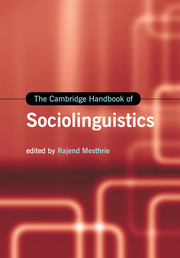Crossref Citations
This Book has been
cited by the following publications. This list is generated based on data provided by Crossref.
2012.
PUBLICATIONS RECEIVED.
Language in Society,
Vol. 41,
Issue. 3,
p.
415.
2013.
A Dictionary of Varieties of English.
p.
363.
2013.
The Guidebook to Sociolinguistics.
p.
195.
2013.
The Guidebook to Sociolinguistics.
p.
1.
2013.
The Guidebook to Sociolinguistics.
p.
333.
Angermeyer, Philipp
2014.
Robert Bayley, Richard Cameron and CeilLucas (eds.). The Oxford Handbook of Sociolinguistics. New York: Oxford University Press. 2013. 912 pp. Hb (9780199744084) $150.00..
Journal of Sociolinguistics,
Vol. 18,
Issue. 1,
p.
125.
Angermeyer, Philipp Sebastian
2015.
The handbooks of sociolinguistics: Defining and dividing the field.
Journal of Sociolinguistics,
Vol. 19,
Issue. 1,
p.
91.
Bacchini, Simone
2015.
When language met society: sociolinguistics in the twenty-first century.
English Today,
Vol. 31,
Issue. 2,
p.
62.
Klír, Tomáš
2016.
Sociální kontext slovansko-německého jazykového kontaktu : severovýchodní Bavorsko a Chebsko v raném středověku.
Archaeologia historica,
p.
301.
Akande, Akinmade
2016.
Multilingual practices in Nigerian army barracks.
African Identities,
Vol. 14,
Issue. 1,
p.
38.
2016.
Sociolinguistic Styles.
p.
192.
Restaneo, Pietro
2017.
Governing the word: Antonio Gramsci and Soviet linguistics on language policy.
Language & History,
Vol. 60,
Issue. 2,
p.
95.
Susen, Simon
2017.
The Wiley‐Blackwell Encyclopedia of Social Theory.
p.
1.
LeBlanc, Robert Jean
2018.
Managed confrontation and the managed heart: gendered teacher talk through reported speech.
Classroom Discourse,
Vol. 9,
Issue. 2,
p.
150.
Swiggers, Pierre
2018.
Editée par/Edited by Anne Aarssen, Ekaterina Bobyleva, René Genis, Sijmen Tol and Eline van der Veken, with the assistance of Femmy Admiraal, Nadia van den Berg and Nozomi Cho.Linguistic Bibliography for the Year 2015 and supplement for previous years.
Historiographia Linguistica,
Vol. 45,
Issue. 3,
p.
403.
Rothman, Jason
González Alonso, Jorge
and
Puig-Mayenco, Eloi
2019.
Third Language Acquisition and Linguistic Transfer.
Kortmann, Bernd
2020.
English Linguistics.
p.
201.
Edwards, John
2020.
Bridging Linguistics and Economics.
p.
224.
Johnstone, Barbara
2020.
The International Encyclopedia of Linguistic Anthropology.
p.
1.
2020.
Languages in Space and Time.
p.
179.



